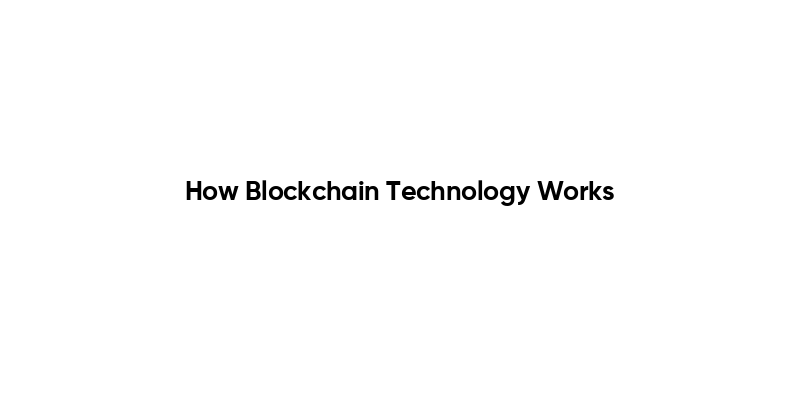Blockchain technology has emerged as a revolutionary force in the digital landscape, fundamentally changing how we think about data security, transparency, and trust. At its core, how blockchain technology works involves a decentralized ledger system that records transactions across multiple computers, ensuring that the information is immutable and accessible to all participants. This innovative approach not only enhances security but also fosters a new level of collaboration and efficiency in various sectors, from finance to supply chain management.
In this article, you will delve deeper into the intricate workings of blockchain technology. We will explore the essential components that make up a blockchain, including blocks, nodes, and miners, and how they interact to create a secure and transparent network. Additionally, you will learn about the different types of blockchains, such as public, private, and consortium blockchains, and their unique applications in real-world scenarios.
Furthermore, we will discuss the potential challenges and limitations of blockchain technology, as well as its future prospects in an increasingly digital world. By the end of this article, you will have a comprehensive understanding of how blockchain technology works and its implications for various industries. So, stay with us as we unravel the complexities of this groundbreaking technology and discover how it is shaping the future of our digital interactions.
Understanding Blockchain Architecture
Blockchain technology is fundamentally built on a decentralized architecture that allows for secure and transparent transactions. At its core, a blockchain consists of a series of blocks, each containing a list of transactions. These blocks are linked together in chronological order, forming a chain. This structure ensures that once a block is added to the chain, it cannot be altered without the consensus of the network, making it highly secure against tampering.
The decentralized nature of blockchain means that no single entity has control over the entire network. Instead, multiple participants, known as nodes, maintain a copy of the entire blockchain. This redundancy enhances security and reliability, as the failure of one node does not compromise the integrity of the entire system. Additionally, the use of cryptographic hashing ensures that each block is securely connected to the previous one, further safeguarding the data.
The Role of Consensus Mechanisms
Consensus mechanisms are critical to the functioning of blockchain technology, as they ensure that all participants in the network agree on the validity of transactions. There are several types of consensus algorithms, with Proof of Work (PoW) and Proof of Stake (PoS) being the most widely known. PoW requires participants, known as miners, to solve complex mathematical problems to validate transactions and create new blocks. This process consumes significant computational power and energy.
On the other hand, PoS allows participants to validate transactions based on the number of coins they hold and are willing to “stake” as collateral. This method is more energy-efficient and encourages users to hold onto their assets, promoting network stability. Understanding these mechanisms is essential for grasping how blockchain maintains its integrity and security while facilitating decentralized transactions.
Smart Contracts and Their Applications
Smart contracts are self-executing contracts with the terms of the agreement directly written into code. They run on blockchain networks, allowing for automated and trustless transactions. Once the predefined conditions are met, the smart contract executes automatically, eliminating the need for intermediaries. This feature significantly reduces transaction costs and increases efficiency.
Smart contracts have a wide range of applications, from financial services to supply chain management. For instance, in real estate, smart contracts can automate the transfer of property ownership once payment is confirmed. This innovation not only streamlines processes but also enhances transparency, as all parties can view the contract’s execution on the blockchain. The potential for smart contracts to revolutionize various industries is immense, making them a key component of blockchain technology.
Blockchain Security Features
Security is one of the most significant advantages of blockchain technology. The combination of cryptographic techniques, decentralized architecture, and consensus mechanisms creates a robust security framework. Each transaction is encrypted and linked to the previous transaction, making it nearly impossible to alter any information without detection.
Moreover, the distributed nature of blockchain means that data is stored across multiple nodes, reducing the risk of a single point of failure. In addition, the transparency of blockchain allows participants to audit transactions easily, further enhancing trust in the system. These security features make blockchain an attractive solution for industries that require high levels of data integrity, such as finance, healthcare, and supply chain management.
Future Trends in Blockchain Technology
The future of blockchain technology is promising, with ongoing developments and innovations expected to shape its evolution. One significant trend is the integration of blockchain with other emerging technologies, such as artificial intelligence (AI) and the Internet of Things (IoT). This convergence can lead to more efficient data management and enhanced security protocols.
Additionally, the rise of decentralized finance (DeFi) is transforming traditional financial systems by providing users with direct access to financial services without intermediaries. As more businesses and individuals recognize the benefits of blockchain, its adoption is likely to increase across various sectors. Understanding these trends is crucial for anyone looking to stay informed about the future of blockchain technology and its potential impact on the global economy.
Blockchain technology is a decentralized digital ledger that records transactions across many computers in a way that the registered transactions cannot be altered retroactively. This technology is the backbone of cryptocurrencies like Bitcoin and has various applications across different industries.
| Concept | Description |
|---|---|
| Decentralization | Unlike traditional databases controlled by a central authority, blockchain operates on a peer-to-peer network where each participant has access to the entire database. |
| Blocks | Data is stored in blocks, which contain a list of transactions. Each block is linked to the previous one, forming a chain. |
| Hashing | Each block contains a unique hash (a cryptographic signature) that identifies it and links it to the previous block, ensuring data integrity. |
| Consensus Mechanisms | To validate transactions, blockchain uses consensus algorithms like Proof of Work (PoW) or Proof of Stake (PoS) to ensure all participants agree on the state of the ledger. |
| Transparency | All transactions are visible to participants in the network, promoting transparency and trust among users. |
| Immutability | Once a transaction is recorded on the blockchain, it cannot be altered or deleted, providing a permanent record. |
| Smart Contracts | Self-executing contracts with the terms of the agreement directly written into code, allowing for automated and trustless transactions. |
| Applications | Blockchain technology is used in various sectors including finance, supply chain, healthcare, and voting systems, among others. |



